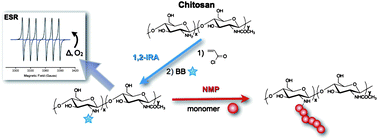Chitosan (CS) is a natural polysaccharide which displays excellent biological properties such as biocompatibility, biodegradability, and antibacterial and wound-healing activity. CS has thus promising applications in many fields such as biomedicine, wastewater treatment, functional membranes and flocculation. In order to circumvent the main drawbacks of CS such as its solubility only in acid solutions and its poor mechanical properties compared to synthetic polymers, CS has been modified by chemical treatments and more efficiently by graft copolymerization. However, these methods of grafting do not generally allow controlling the molecular weight and the number of grafted chains. Controlled/living radical polymerization have therefore opened new prospects in this domain.
In this context, Lefay and co-workers reported an efficient CS modification method based on nitroxide-mediated polymerization (NMP) under heterogeneous conditions. After introduction of acrylamide and/or acrylate functions onto the CS backbone followed by intermolecular 1,2 radical addition of the BlocBuilder alkoxyamine, methyl methacrylate in the presence of a small amount of acrylonitrile or sodium 4-styrenesulfonate was successfully polymerized by NMP under the SG1 nitroxide control. Analyses revealed that 20-30 wt% of synthetic polymers were grafted onto the CS backbone, yielding a hybrid material with potential applications such as a biocompatibilizer.
Heterogeneous modification of chitosan via nitroxide-mediated polymerization by Catherine Lefay, Yohann Guillaneuf, Guillaume Moreira, Joel J. Thevarajah, Patrice Castignolles, Fabio Ziarelli, Emily Bloch, Mohamed Major, Laurence Charles, Marianne Gaborieau, Denis Bertin and Didier Gigmes, Polym. Chem., 2013, 4, 322-328.
Julien Nicolas is a guest web-writer for Polymer Chemistry. He currently works at Univ. Paris-Sud (FR) as a CNRS researcher.











